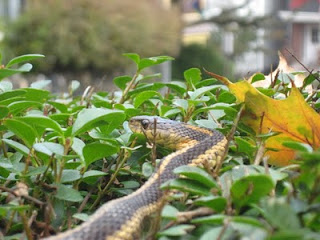*****
Many years ago a poor old man lived alone with his equally poor old wife.
They had a hard life working their meager farm out in the woods. The soil was rocky and the growing season short. They were so poor they didn't even have any horses to pull their plough. The old man had to do it himself.
One day while the old man was out dragging his plough across the field the Devil showed up.
"Hey there old fella," the Devil said. "That looks like awfully hard work. Wouldn't you rather have two strong horses to do that for you?"
The old man said, "Of course I would! But I don't have any money."
The Devil said, "Well, then I have a deal for you. I'll give you a team of horses, and you just have to give me one small thing..."
The old man knew he was talking to Satan. He said, "I'm not giving you my soul!"
The Devil paused thoughtfully, and then he said, "OK, but how about this? I give you a team of horses now, and then in one year I'll come back and cut off your genitals."
The old man considered the offer for a moment. He was quite old, as was his wife, and he didn't use his genitals as much as he used to. He probably wouldn't even miss them...
"It's a deal," he said. He and the Devil shook hands. The Devil vanished, and two strong horses appeared. The man hitched them up to his plough and went back to work.
Many months went by. At first the old man thought he had gotten a good deal, but he started to reconsider as the anniversary of his bargain approached. Maybe it hadn't been such a good idea after all...
The night before the Devil was supposed to claim his payment the old man just lay in bed and cried. His wife asked him what was wrong.
When she found out what he had done she was furious. "You idiot! I'll fix this. You just stay in bed and cry like a baby."
The next morning the old woman put on her husband's pants, coat and hat. Looking just like her husband, she went out into the field to meet the Devil.
The Devil was waiting there with a big knife in his hand. He smiled and said, "Hello old man! I've come to collect my payment."
The old woman smiled right back. She dropped her trousers and said, "I was afraid you would cut too deep, so I cut them off myself. See?"
The Devil stared down at the woman's exposed body. He said, "Well old man, you fooled me, but you paid the price anyway." And with that he disappeared.
*****
Really, what can be said about this story? I'll just add two little comments.
First, this is another story where someone cheats the Devil. It's a common theme in folk stories, and the joy of these stories is seeing how the hero does (or doesn't) get out of his bargain. Happily the old man's wife knows how to trick the Devil.
Second, French Catholic missionaries converted the Penosbscots in the early 1600s. Still, it's interesting to see how Christianity has been incorporated into the Penobscot worldview. I think this story might be a good example of how the two belief systems interact. It's certainly not something you'd find in the Bible! Another good example is this violent story about a rabbit impersonating a priest. Christianity isn't a uniform monolithic religion across the world. Different cultures do different things with it.










